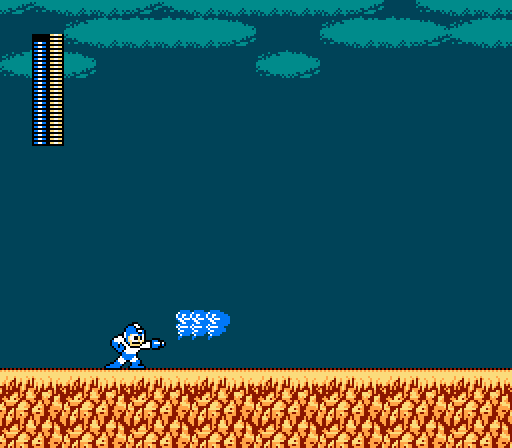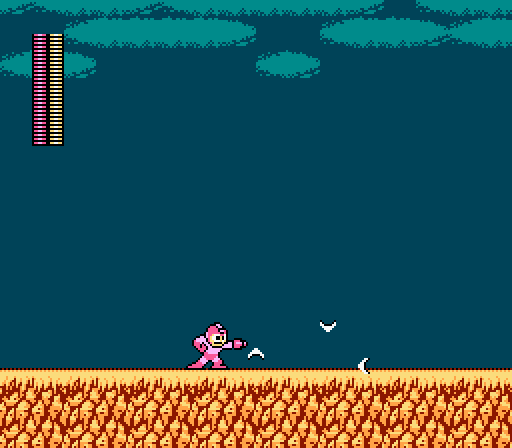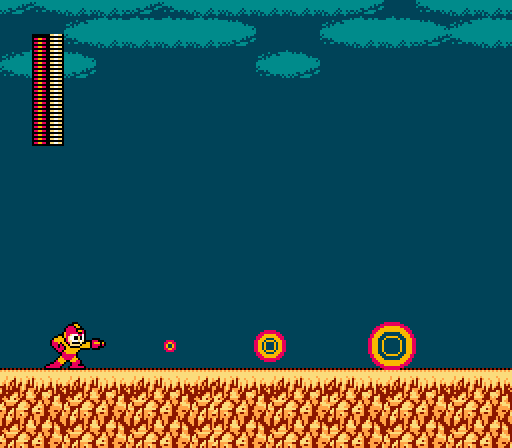Mega Man 2 maintains many of the first game’s mechanics and design choices, including what would go on to be the essence of practically every Mega Man series save Legends: Fighting robots, then claiming their weapons as your own. And, as before, every Robot Master proves to be extremely weak to one of their comrade’s powers, and often suffers a secondary, though less severe, weakness to at least one other weapon.
Furthermore, every Robot Master completely resists at least one weapon, and — totally new to Mega Man 2 — there’s also a better-than-even chance that a Robot Master will be completely healed if you try to use his own weapon on him. So don’t try it.
The weapon weaknesses in Mega Man 2 (with a handful of exceptions) tend to be less variable than in the first game. On the other hand, as noted before, every single power-up you collect in the game is vastly more usable in the course of normal gameplay than the fickle arsenal of the original game. There are times when your extra weapons have obvious strategic value in a given situations, but you’ll also find advantages in breaking out your accumulated powers against a variety of mundane minor robots. A lazy player can probably get along with nothing but the Metal Blade for much of the game, but a smart player will swap equipment at every possible opportunity to breeze through the game. Experimentation yields great results in Mega Man 2.
Bubble Lead
Bubble Man’s weapon seems weirdly impractical at first glance: You fire large bubbles that rise up slightly before dropping to the floor and rolling along the surface. They do have the minor advantage of rolling straight up walls, but few enemies cling to walls… and even more annoyingly, some of the enemies that are too short to hit with your standard cannon, who would seem ideal candidates to take out with the Bubble Lead, are completely immune to its projectiles. The bubbles bounce right off.
So what’s the point, aside from using it against Heat Man, the one boss who can’t withstand its power? Well, the answer resides in the weapon’s name. The “lead” in Bubble Lead is pronounced with a long E, not a short one — as in “to show the path forward,” not “a dense and toxic metal.” And the Bubble Lead is great for leading the way in tricky or uncertain ground; for example, in one area that features hidden pit traps, the Bubble Lead can reveal the invisible holes you need to leap to safety.
It’s also the only weapon that works at all against the very final boss, kicking off a longstanding tradition of final Mega Man battles that have to be won with the most inconvenient possible power-up.

Air Shooter
The Air Shooter’s utility is somewhat undermined by the versatility of the Metal Blade, which is a shame. The weapon addresses a significant shortcoming in the original Mega Man’s arsenal: No efficient way to hit enemies above you. In the previous game, only the Thunder Wave could hit enemies up high, and you had to stand directly beneath them to do so. The limitations of that power really showed in the final leg of Dr. Wily’s stage, when you had to stand and try to hit the pop-out cannons that lined the ceiling and floor without taking a hit in return.
The Air Shooter neatly rectifies that limitation by giving you a weapon that fires upward. While it doesn’t travel directly up, it instead does something that in its own way proves to be better: The three blasts of wind it fires (represented as blue tornadoes) drift apart as they move forward and upward, resulting in a wide spread that covers a respectable chunk of the ceiling. It’s great for dealing with threats above you quickly — you can fire and forget, so long as you aimed in roughly the right direction. The Air Shooter’s projectiles also tend to have a piercing effect, passing through any enemy they destroy to hit whatever lies beyond. In some of the more vertically oriented stages, it proves to be a massive boon… even if, again, Metal Blade outclasses it in terms of practicality.

Quick Boomerang
The secret of MVP of Mega Man 2, the Quick Boomerang doesn’t initially seem to have much value. It’s like a Rolling Cutter with less range and lacking that device’s piercing effect. So, who cares?
The trick to Quick Boomerang’s value is in its rapid-fire ability. Hold down the fire button and Mega Man will emit a flurry of Quick Boomerangs; you won’t be able to run or jump as you’re firing, but it doesn’t matter. You blast out so many projectiles in a stream that practically anything in their path will be vaporized in an instant. The Quick Boomerang isn’t particularly powerful (though it’s surprisingly effective in situations you might not expect), but its rate of fire and low cost of use make it a great go-to weapon — a much better moment-to-moment weapon choice in most cases than the trusty P shooter, in fact.
Every weapon in Mega Man 2 languishes in the shadow of the almighty Metal Blade, but Quick Boomerang has charms enough that you might just find it becoming a common go-to… especially if you feel guilty about breezing through the game with Metal Man’s overpowered weapon.

Atomic Fire
The most complex weapon in Mega Man 2, Atomic Fire is only worth using if you’re willing to take advantage of its special feature: The ability to charge it up and launch super-powered fire attacks. If you simply tap the fire button while equipped with the Atomic Fire, Mega Man will attack with small rings of fire — slightly wider than his normal attacks, but not really any more powerful. Hold down the fire button, however, and Mega Man will begin charging the Atomic Fire, humming and shimmering to indicate his stored-up attack power. After a couple of seconds, the charging sound will change pitch. At that point, releasing the fire button will unleash a much larger torus of flame that hits roughly three times as hard as the default attack.
But if you wait for the humming to oscillate to its highest pitch, a few seconds longer, Mega Man’s attack will take the form of an absolutely massive fireball, the height of Mega Man himself, capable of incinerating just about everything in its path. Several bosses in the game will fall to two hits of the fully-charged Atomic Fire, making it the game’s most powerful weapon (the only similarly potent combinations are the Flash Stopper against Quick Man and the Metal Blade against its own owner).
The downside? Each level of charge power doesn’t simply take a couple of seconds to build up to, they also exact a significant cost on the Atomic Fire’s battery. Mega Man only has the juice to fire a couple of level three Atomic Fires before needing to find a recharge. The time and energy cost make the Atomic Fire an extremely powerful weapon, but an extremely situational one.
Images courtesy of the Mega Man wiki

Heh, I get saving the best for last, but with all the comparisons, maybe the Metal Blade should have come first. 😉
You know, I think I long forgot about Quick Boomerang having a rapid fire like that. I’d just run and button mash to good effect, but I forgot about just holding the button down.
Atomic Fire is rather interesting. It’s a clear precursor to the concept of giving the Mega Buster a charge shot, but they skipped a game to do it, and later felt it basically broke the difficulty. Makes you wonder why they did it at all.
Regarding recharges from one’s own weapon: If I’m not mistaken, I think Crash Bombs have a healing effect on Heat Man, too, don’t they? I know we’re not to that yet, but I’m just trying to remember if that was actually in-game or just in fiction.
I’m going in the order in which the Robot Masters are shown on the stage select screen, as I did with the first game.
Just an FYI Jeremy - this comes across as really acerbic and snappish. I don’t think LBD meant anything critically negative by his comment.
Fine, edited.
Yeah, I forgot that’s what happened in the last one- and I didn’t realize this was the stage select order here, either. For some reason, I always think Air Man is in the top left- probably from Nintendo Power having him first in their initial review.
I recall the Quick Boomerangs as being one of my favorite robot master weapons of any MM game — they were plentiful, quick-acting, versatile, and shaded Mega Man a unique, pleasing shade of pink. I especially enjoyed using it to farm moles and scworms for extra lives and refills in Wily’s Castle, but I suspect that’s pretty much universal to everyone’s experience.
I plead guilty on the Atomic Fire. Aside from the obvious explosive attack on Wood Man and maybe the Hot Dogs in the same stage, I can’t think of when else I pulled that weapon out. Looking forward to discovering more uses for it.
It’s good for taking out Sniper Joes and the Lantern Fish.
Overall 2,4 and 9 are probably the top of the class for weapon selection, though 4 does a lot of note-stealing from 2
I actually think every Mega Man fan should try playing all the way through 2 without ever using the Metal Blade. You almost have to do that to appreciate how diverse the weapon selection is, and how useful each of the weapons is in its own way, especially if you normally go through the game without ever using, say, Leaf Shield or Quick Boomerang. Once you get a decent idea of what weapon to use where, it’s not really even noticeably harder (well, except for the Metal Man rematch I guess, but by the time you get there, you’ve already beaten him without using the Metal Blade, and he’s one of the easier bosses anyway.)
Actually, I’d say Mega Man 2 has the overall best lineup of weapons in the series. It and X1 are the only games where I find myself really wanting to use all the weapons outside of boss battles. Its only real flaw in that respect is that the Metal Blade tends to overshadow everything else, and that might not even be the case if the Metal Blade was in one of the later games (as the series goes on, there seem to be more and more enemies with some way of blocking your attacks, which means you have to pay attention to their weak points rather than just spamming rapid-fire shots. Or just use something that penetrates their defenses.)
I wonder why they came up with the idea of certain Robot Masters being healed by their own weapons. The thing is, this isn’t like an RPG where there’s a whole category of fire-based attacks, any enemy that absorbs any of them absorbs all of them, and you almost certainly have at least one available before the first boss battle. You’ll only ever have a Robot Master’s own weapon to use against him during the rematches, so the only way the healing can even come into play is if you smack him around with one weapon (that you already know is more effective, since you’ve beaten him with it before) and then, midway through the battle, you decide to change to shooting him with his own weapon for whatever weird reason. If you hit him with his own weapon first, it won’t do anything, since he’s already at full life, and you’ll just say “well that didn’t work, I guess I’ll just use the Metal Blade.” It seems a bit pointless, which might be why that doesn’t happen in any of the later Mega Man games. I seriously didn’t know that mechanic even existed in Mega Man 2 until I heard someone mention it on a web forum in about 2012 or so.
I think they added the feature just because they could. MM2 was the kind of game where the designers said, “What if we… yes, let’s!”
The Air Shooter justifies its existence by being a really great weapon for quickly tearing apart those Sniper Joe walkers with less risk of taking damage.
I always just blasted them with Quick Boomerangs, which have the side benefit of making short work of the Sniper Joes who drop from the walkers.
Huh. I too never knew about the robot masters being healed by their weapons. You can always tell which games were being designed by people who were really into what they were doing by the weird little details that end up in them.